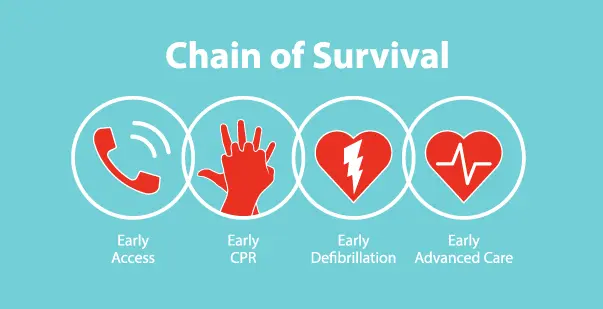
Last Updated on: August 12, 2024
Table Of Content(s)
During emergencies, every second counts. The rapid response of bystanders and emergency responders can make the difference between life and death. The chain of survival is a concept that optimizes the chances of survival for individuals experiencing life-threatening emergencies. To deliver the best and timely response to a person in need, it is important to understand the different steps in the chain of survival.
In this blog, we will explore through the various links in the chain of survival. By implementing these steps effectively, you can significantly improve the outcomes for patients suffering from sudden cardiac arrest and other emergencies. Read along to understand each link in detail.
The chain of survival consists of different links. Each link in the chain represents a critical step in the emergency operation. Together these links form a strategy that maximizes the effectiveness of medical intervention. Here are the different links in the chain of survival and their purposes:
Read More: How do you perform CPR on a drowned person?
Read More: Implications of CPR: Can You Get Sued for Performing CPR?
Surviving a cardiac arrest is just the beginning of the journey towards recovery. The days following the return of spontaneous circulation are critical for ensuring a patient’s long-term health. Post cardiac arrest care is a comprehensive approach that aims to stabilize the patient, minimize neurological damage and prevent recurrence. Here are the key components of post cardiac arrest care:
Therapeutic Hypothermia (Targeted Temperature Management): To reduce brain damage by lowering the body’s temperature, which helps protect the brain and other vital organs. This is typically achieved by cooling the patient to a specific target temperature for a set period.
Hemodynamic Stabilization: To maintain optimal blood pressure and cardiac output. This involves careful monitoring, management of fluids, medications, and mechanical support. This ensures the heart and other organs receive adequate blood flow.
Neurological Monitoring and Management: To assess and support brain function, including the prevention of secondary brain injury. This may include regular neurological assessments, electroencephalograms (EEGs), and medicines to manage seizures.
Respiratory Support: To ensure adequate oxygenation and ventilation. Patients may require intubation and mechanical ventilation initially, followed by weaning to less invasive support as they stabilize.
Cardiac Care and Intervention: To address any underlying cardiac issues that may have contributed to the arrest, such as coronary artery disease or arrhythmias. This involves cardiac catheterization, angioplasty, or the implantation of pacemakers or defibrillators.
Infection Control: To prevent and manage infections due to invasive procedures or the patient’s critical condition. This includes using antibiotics, sterile techniques, and observing for signs of infection.
Rehabilitation and Follow-up Care: To support the patient’s physical and cognitive recovery through rehabilitation services, including physical therapy, occupational therapy, and psychological support. Long-term follow-up is essential to monitor for complications and support the patient’s return to daily activities.
The chain of survival represents a structured and systematic approach to seamlessly intervene in life-threatening emergencies. The chain of survival, when followed diligently, enhances positive patient outcomes. When bystanders are equally prepared to act decisively in emergencies, the chain of survival gets stronger. Every link in the chain is vital, and your actions can be the deciding factor in saving a life.